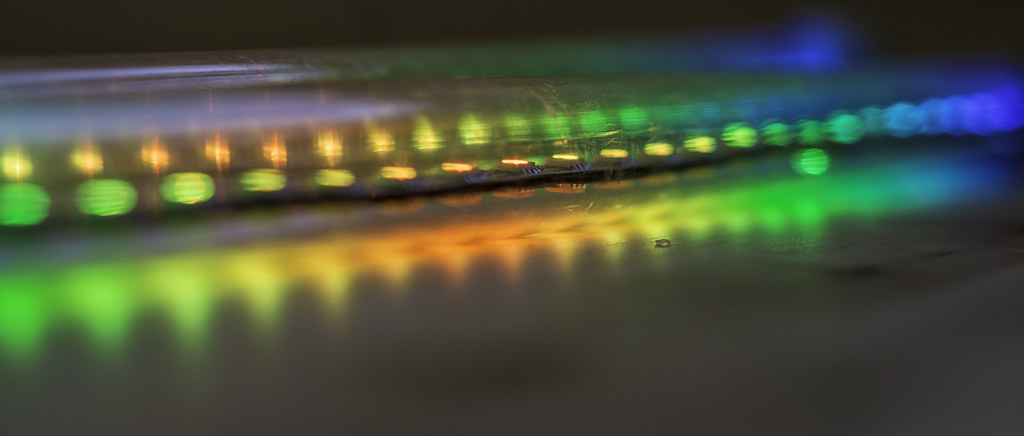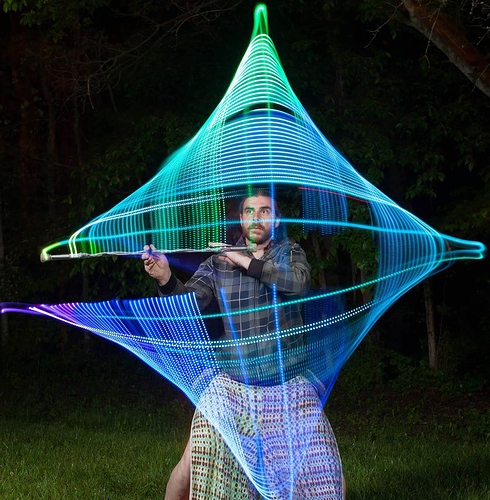So the WS2811 Datasheet states that they are ‘constant current’ devices (current mode PWM?) - constant current would make me think there would be no tearing - but PWM constant current would indicate tearing. Anybody know for sure? Example photo with tearing (dotting…) could the dotting be the fastSPI_LED.Show() call? since it has to shove all those values out it makes sense there might be a dark spot when that happens.
You are thinking on the same lines that I did when I first started using the library + WS2811’s to make POV and LED props. However it is actually the PWM itself and the values used for your colors. When using full values you will see solid lines as the LEDS are simply ON and not pulsing at a rate to simulate lesser values.
Another object manipulator in this group? SCHWEEET! Yep, building my own POV doublestaffs to start with. What’s your prop-of-choice?
Flowtoys Podpoi use constant current drivers but I’m guessing they’re REAL constant current LED drivers as they don’t tear/flicker. It would be sweet if there was a 5050SMD RGB LED with a true constant current x3 driver on it.
The flicker is purely the colors used, you can set your props to a solid color with a 255 value to see what I mean.
I spin staff/double staff and some poi 
Here is a set of my pixel staff/POV stuff, you can see that some images show the same dots, and some are solid lines:

Extra sweet! That’s a hell of a lot better staff than the cheap chinese shit that trick is peddling!
This is also starting to give me bad memories of the 216 web-safe color palette in the early days of the web/GIF.
Hahaha, it is pretty sweet, but at the same time I need to make a more durable version. I’m taking a short break from props to make a lot of LED Fur wearables, but I think I will probably give another go at staff (With a gyroscope for better POV), and poi ( I want to get some decent RF Communication going for POI modes to sync up too)… I have completely fallen down the LED Strip rabbithole 
And yeah as for the mode that your prop is doing in the photo, I have a similar progression through the color spectrum for my rainbow’y things where I always have one color LED fully on. So starting at Red 255 and fading in Green from 0 to 255, then keeping green at 255 and fading out red to 0, then fading in Blue to 255 etc etc. You’ll notice that you get the color blends to the human eye, but on camera, one LED is fully on for a straight line, and is being peppered with dots of the other pulsing/not fully on colors.
why the gyro ? being able to figure out an ‘RPM’ for Iso/static spins and therefor tuning the frame delay (writing new values to the strip?)
yeah basically figuring out the rotation/position so I have more ways to adjust modes while the prop is spinning. I had the ability to toggle through modes with a push button, adjust the delay/speed with a potentiometer etc. I would like to move to using force sensors in the grip to toggle modes, having the delay decided by rotation speed… maybe even simulate a fire staff spin off if the staff is spinning fast on its rolling axis by flashing everything white or something like that… I think having more ways to sense input will really give a prop more of a creative outlet 
Hey Chris, how many LEDs do you have in your staff?
That one is 120, 60 Leds (2 sets of 30 back to back) per end.
And you’re using what to power them? The reason I ask is because I’m working on a setup myself and could use some ideas …
For that staff, I’m using 2 3.7 Lithium Ion batteries ( these: http://www.amazon.com/dp/B001JDRPXM though thats just the first google result) and using this regulator from Pololu to step down to 5V with a high efficiency: http://www.pololu.com/catalog/product/2110
That combo can deliver more then 2A of current needed. I have also used many other regulators since then for various portable LED projects with different demands as well. Getting a buck regulator as opposed to linear is of course crucial with the powering these strips. I think I got about 2 hours between charges on that staff.
Boost makes the charging easier but big boost converters (or wide range converters) are hard to come by in anything 15W+ that’s appropriate for use in a prop (size.)
Ok, cool. I’m trying to figure out whether I can run it on a single battery, instead of two. I can drive the MCU with 3.3V no problem. And I can find LEDs with a voltage drop of 3.0V (on the high end). So, technically, on paper, I should be able to do that. But till I try it, I won’t know for sure.
I can drive 1M with a 15W boost converter at full brightness for about 30 mins. Works but the lithiums can’t provide nearly as much current as they discharge than when they are fresh.
Yeah, for some projects I’ve gone single battery, using a Step Up (to 5v) boost regulator and it works fine for 1 Meter, so no need to get special 3v strips I think. Actually looking at data sheets it seems that the higher the voltage the strip requires, the less actual wattage per meter is needed, as you get some gains in efficiency with lowered current requirements.
Oh right, if you’re using prebuilt strips, then yes you have to have that 5V. I’m building custom ones, so I can tolerate the 3.7V on the battery and a Buck/Boost for the 3.3V (Li-Ion battery tops out at 4.2V and discharges to 3.0V.) We’ll see how it goes after I get the custom PCBs in.
Actually, even better. Since I plan on using the 32U4 controller, it can tolerate voltages down to 2.7V and still run 8MHz, so technically I wouldn’t need a Buck/Boost for it. Battery supplies 3.7V and discharges down to 3.0V. So the only thing left is getting the right RGB LEDs that aren’t voltage hogs. 
Oh yeah, this is all custom made, from the controller to the LED configuration. At least, that’s the plan.
